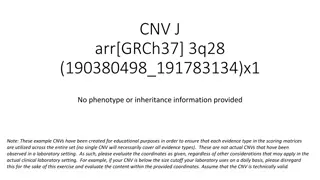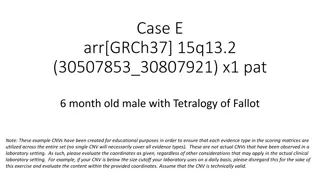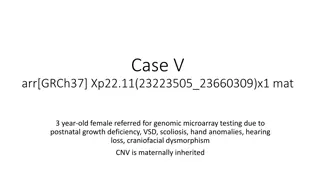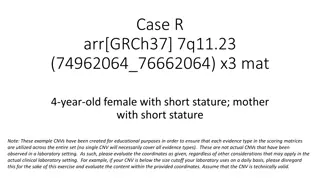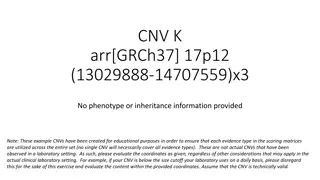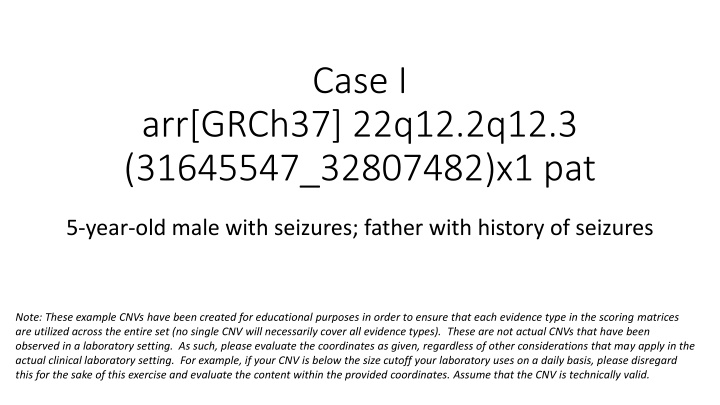
Genomic Deletion Evaluation for Seizures in a 5-Year-Old Male
Explore the genomic deletion on chromosome 22q12.2q12.3 in a 5-year-old male with seizures, which is paternally inherited. Evaluate the involvement of protein-coding genes, overlap with established genes, and assess the impact on genes related to seizure disorders. Dive into a detailed analysis of DEPDC5 and SLC5A1, associated with epilepsy and glucose/galactose malabsorption, respectively. Utilize the LOSS scoring metric for assessment.
Download Presentation

Please find below an Image/Link to download the presentation.
The content on the website is provided AS IS for your information and personal use only. It may not be sold, licensed, or shared on other websites without obtaining consent from the author. If you encounter any issues during the download, it is possible that the publisher has removed the file from their server.
You are allowed to download the files provided on this website for personal or commercial use, subject to the condition that they are used lawfully. All files are the property of their respective owners.
The content on the website is provided AS IS for your information and personal use only. It may not be sold, licensed, or shared on other websites without obtaining consent from the author.
E N D
Presentation Transcript
Case I arr[GRCh37] 22q12.2q12.3 (31645547_32807482)x1 pat 5-year-old male with seizures; father with history of seizures Note: These example CNVs have been created for educational purposes in order to ensure that each evidence type in the scoring matrices are utilized across the entire set (no single CNV will necessarily cover all evidence types). These are not actual CNVs that have been observed in a laboratory setting. As such, please evaluate the coordinates as given, regardless of other considerations that may apply in the actual clinical laboratory setting. For example, if your CNV is below the size cutoff your laboratory uses on a daily basis, please disregard this for the sake of this exercise and evaluate the content within the provided coordinates. Assume that the CNV is technically valid.
Clinical Information arr[GRCh37] 22q12.2q12.3(31645547_32807482)x1 pat 5-year-old male with seizures Variant is paternally inherited Father reported to also have a history of seizures Use the LOSS scoring metric
Section 1: Initial Assessment of Genomic Content Case I Genes Involved Would apply category 1A (contains protein-coding or other known functionally important elements), as this deletion includes numerous protein-coding genes. 0 points; continue evaluation Total: 0 points
Section 2: Overlap with Established/Predicted HI or Established Benign Genes/Genomic Regions Case I Does not include any established P or B genes/genomic regions Total: 0 points
2H: Does CNV I include any predicted HI genes? No. While these 3 genes meet the pLI criteria, they do not meet the %HI criteria. Total: 0 points
Section 3: Evaluation of Gene Number 16 protein-coding genes (Category 3A: 0 points) Total: 0 points
Section 4: Detailed Evaluation of Genomic Content Where to begin? 2 genes in the region, DEPDC5 and SLC5A1 are annotated as OMIM Morbid genes SLC5A1 has been evaluated by ClinGen Dosage Sensitivity as a gene associated with an AR condition (glucose/galactose malabsorption) DEPDC5 is associated with an AD epilepsy syndrome per OMIM Assess DEPDC5 for evidence of haploinsufficiency
Dibbens et al. 2013 (PMID:23542697) Identified multiple putative loss of function (LOF) variants in families with familial focal epilepsy with variable foci (FFEVF) Phenotype notable for intrafamilial variability affected individuals within the same family noted to have seizures originating from different cortical regions Seizure onset varied from infancy to adulthood Affected individuals typically have normal intellect, though some may have intellectual disability, psychiatric disorders, and/or autism spectrum disorder Known to be associated with reduced penetrance Estimated ~66% penetrance using 7 large families from the study (range 50-82%) Exome sequencing identified variants in families A1 and D1 (next slide) Sanger sequencing of DEPDC5 in 6 additional large families with linkage to the same genomic region variants identified in 5 Scanned DEPDC5 by high resolution melt curve analysis in 82 unrelated probands from families with at least 2 individuals with focal epilepsy without a detectable structural etiology 10 additional variants identified
Dibbens et al. 2013 (PMID:23542697) Arbitrarily designating as proband (not identified in publication) Conservative counting: even if we just counted genotype+/phenotype+ individuals (no unaffected obligate carriers), we would still have >7 segregations (Category 4H, 0.45 points) This is the maximum amount of points to be awarded for segregation evidence. Score subsequent family variants using Category 4E, default 0.1 each. Total: 0.45 points
Dibbens et al. 2013 (PMID:23542697) Several other variants are described in this paper, and many more are described in the literature Many of these could also be scored, but it is always preferable to get evidence from independent sources when available For the purposes of this example, we will obtain additional evidence from other publications as well. Family Variant Score Notes J c.1459C>T (p.Arg487Ter) 0.1 K c.2527C>T (p.Arg843Ter) 0.1 M c.3311C>T (p.Arg1268Ter) 0.15 De novo; parental relationships confirmed Total: 0.80 points
Ishida et al. 2013 (PMID:23542701) Describes multiple families with variants in DEPDC5, including the French family N, with a history of FFEVF Exome sequencing identified c.1122delA in exon 16, leading to a frameshift and a premature stop codon (p.Leu374fs*30). Category 4E, 0.1 point Total: 0.90 points
Tsai et al. 2016 (PMID:28170089) c.4203+2T>A identified via exome sequencing in a Taiwanese family with history of FFVEF mRNA from proband s lymphocytes demonstrated an additional band compared to controls Sequence analysis confirmed that the variant caused skipping of exon 39, resulting in frameshift and premature truncation (p.Ala134GlyfsTer56) Segregation scoring already maxed out; score using category 4E (0.1 point) Total: 1.0 points
Population Data No population deletions of similar size/genomic content observed in either gnomAD or DGV Gold Standard data set as of May 2020.
Section 5: Evaluation of Inheritance Pattern/Family History for Patient Being Studied Our patient is a 5-year-old male with a personal and family history of seizures (present in the father) The variant is inherited from the father. Though we are not given any more specific information about the seizure type, onset, etc. in either individual, this history is consistent with what has previously been reported with loss of DEPDC5 Through published evidence alone we have enough to reach Pathogenic. If this was not the case, however, we could have added points via Category 5D. Total: 1.0 points
Conclusion Classification: Pathogenic Haploinsufficiency of the DEPDC5 gene has been associated with familial focal epilepsy with variable foci (FFEVF), a condition associated with variable expressivity within and between families, as well as reduced penetrance.

